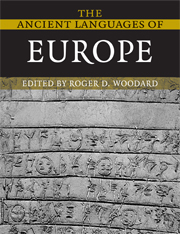Book contents
- Frontmatter
- Contents
- List of figures
- List of tables
- List of maps
- List of contributors
- Notes on numbering and cross-referencing
- List of abbreviations
- Preface
- Preface to the first edition
- 1 Language in ancient Europe: an introduction
- 2 Attic Greek
- 3 Greek dialects
- 4 Latin
- 5 Sabellian languages
- 6 Venetic
- 7 Etruscan
- 8 Continental Celtic
- 9 Gothic
- 10 Ancient Nordic
- Appendix 1 Indo-European
- Appendix 2 Full tables of contents from The Cambridge Encyclopedia of the World's Ancient Languages, and from the other volumes in the paperback series
- Index of general subjects
- Index of grammar and linguistics
- Index of languages
- Index of named linguistic laws and principles
8 - Continental Celtic
Published online by Cambridge University Press: 01 September 2010
- Frontmatter
- Contents
- List of figures
- List of tables
- List of maps
- List of contributors
- Notes on numbering and cross-referencing
- List of abbreviations
- Preface
- Preface to the first edition
- 1 Language in ancient Europe: an introduction
- 2 Attic Greek
- 3 Greek dialects
- 4 Latin
- 5 Sabellian languages
- 6 Venetic
- 7 Etruscan
- 8 Continental Celtic
- 9 Gothic
- 10 Ancient Nordic
- Appendix 1 Indo-European
- Appendix 2 Full tables of contents from The Cambridge Encyclopedia of the World's Ancient Languages, and from the other volumes in the paperback series
- Index of general subjects
- Index of grammar and linguistics
- Index of languages
- Index of named linguistic laws and principles
Summary
HISTORICAL AND CULTURAL CONTEXTS
The term Continental Celtic does not refer to a single linguistic entity – it is not a synonym for Gaulish – but to the entirety of the Celtic linguistic documentation from the ancient European continent. At the present time we can distinguish a discrete language called Hispano-Celtic (also known as Celtiberian), spoken in the north central meseta of the Iberian peninsula, from Gaulish, varieties of which were spoken from Asia Minor in the east through central Europe southward into the northern Italian peninsula and extending to the English Channel and eventually, with the Belgic migrations, over it into Britain. The variety of Gaulish spoken around the northern Italian lake district, usually called Lepontic, and that spoken in Asia Minor, usually called Galatian, are viewed by some as separate languages, though this view has weakened in recent years (Eska 1998b; cf. Uhlich, forthcoming). It is now commonly believed that Hispano-Celtic first separated from the Proto-Celtic speech area in central Europe sometime in the early first millennium BC, and developed henceforth on its own. The remainder of the Proto-Celtic speech area then developed as a dialect continuum as speakers spread across Europe and into Asia Minor. The traditional view is that this continuum subsequently divided into a Goidelic branch and a Gallo-Brittonic branch, but an increasing number of scholars have begun to stress the prehistoric unity of Insular Celtic as opposed to Gaulish.
- Type
- Chapter
- Information
- The Ancient Languages of Europe , pp. 165 - 188Publisher: Cambridge University PressPrint publication year: 2008
- 2
- Cited by



